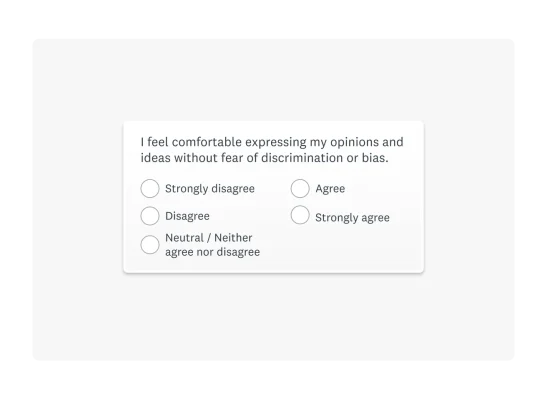10 student survey templates that will get you reliable feedback
What are good survey questions to ask students? Learn how a well-designed student survey can boost participation and produce powerful insights.

Summary:
- Templates are designed to cover various stakeholders, including students, parents, teachers, and administrators, to gather comprehensive feedback.
- Standardized questions help schools assess school climate, course effectiveness, and student engagement consistently over time.
- Using pre-built templates accelerates the feedback process and ensures questions are methodologically sound and unbiased.
Your students make the biggest impact on your school environment and ultimate success. And that's why it’s important to regularly collect their feedback to see where you can improve.
Institutions like the US Department of Education and Harvard Graduate School of Education understand the value of good education surveys. So, we collaborated with their experts to create these student survey templates.
These focused student surveys are designed to minimize bias and encourage participation. They also address important topics, from parent engagement to student satisfaction.
Read this article for our top sample student survey questions and full surveys you can use immediately. You’ll also learn education survey design best practices and get tips for increasing student participation.
What are student survey templates?
Student survey templates collect student feedback on any aspect of the learning process. Student surveys can include questions about teaching quality, course evaluations, facilities, satisfaction, and many other topics. Administrators and educators can use student feedback to identify and fix student experience issues.
Why are student surveys important?
Student survey templates are great tools for gathering valuable insights to implement changes in a school or university environment. The data collected from student questionnaires allows administrators and other educational leaders to make informed decisions.
Teacher evaluation
Use surveys as an effective teacher evaluation tool. Ask students questions that gather feedback on educator effectiveness, including lessons and teaching style. Additionally, these surveys can gauge how students feel about faculty members and help you address any complaints. Teachers can also use these evaluation and feedback forms to improve and advance their careers.
Improve learning outcomes
Sending student surveys regularly generates insights that help you improve learning experiences. That win has ripple effects—reducing course dropout rates, increasing graduation rates, and boosting overall student success. Asking questions about a specific course’s format or educational content can give educators insight into what students liked and disliked.
Data-driven decisions
Survey insights help improve the learning environment for both students and teachers. When you collect feedback, you make staff members and students feel supported and valued. Of course, following up on student feedback is important, too. Use the data to make decisions impacting curriculum, course format, and more.

Example of survey questionnaire for students by use case
Satisfaction with faculty
Determine students’ perception of professors and instructors with a university faculty satisfaction survey. Ask students about the faculty member’s teaching style, ease of communication, extra support, and if they would take other courses taught by the instructor.
Internet and social media safety
Are students acting appropriately and safely using their university email, Facebook, Instagram, X (formerly Twitter), and the internet in general? SurveyMonkey developed questionnaires for students to determine how, where, and when they use social media.
With these surveys, you can get answers to questions such as, “When you’re on social networking websites (like Facebook), how much of your time do you spend posting things about other people?” For the best results, ensure students know these surveys are anonymous and secure.
Parental involvement
If you wonder what parents think about your educational institution and their student’s success, sending a survey is a great option for collecting candid feedback. Do parents have time to actively participate in their students' education? Send a parent survey to ask questions such as “How confident are you in your ability to support your child’s learning at home?”
Overall climate and mood
Give students the opportunity to share their thoughts and feelings about their school community or campus. Do they feel fully supported by their teachers and other staff members? Are there issues with students being mistreated or bullied by others? A student survey can uncover areas that need to be addressed by the administration.
How do students across the country feel about distance learning, campus safety, and post-pandemic learning? We did the research and can tell you what students nationwide think. Watch our webinar to find out.

How to create a student survey
1. Set a goal
To begin, set a clear goal for your student survey. This goal will guide your focus and inform the questions you ask. Your goal will also help you keep your survey short, which is better for you (and your students). Respondents often abandon surveys that are too long or contain too many different topics if they get bored or tired of answering questions.
2. Understand your audience
Understanding your audience is extremely important when creating a survey. In this case, your target audience is students of your educational institution. However, you must be intentional and develop questions carefully, using clear and direct language.
Design respectful and inclusive questions and avoid bias or assumptions about gender identity. Additionally, when asking questions about topics that may be sensitive to some students, give respondents the option to decline to answer.

3. Choose your questions
Next, it’s time to choose what questions to ask in your student survey. The questions you choose to ask should be clear and simple for respondents. Consider using a mix of open and closed-ended questions to give some variety and glean deeper insights. This helps ensure you get students to answer your survey.
4. Format the survey
Format the student survey in a logical way that flows naturally from question to question. This enables you to get honest student feedback and helps promote completion. Vary your questions and brand your survey with your school colors and logo.
5. Test and measure
It’s smart to test your survey with a small group of people before you launch. Ask your survey testers if they thought anything was confusing or seemed broken. You’ll also want to examine the results and analyze the data to be sure the survey captured the intended information and meets the goal you set.
6. Distribute the survey
Once you’ve polished your survey for students and tested it with a small group of respondents, it’s time to send it. We recommend sending it via a school email or by SMS. Consider adding an incentive, like a raffle or small gift, to encourage student participation.

Student survey templates
Ready to create a student survey? Check out our customizable education survey templates, written by experts, to minimize bias and get reliable results. Customize them how you want and send your survey in minutes. Or keep reading for an overview of our most popular student survey templates.
General education surveys
Education demographics template
Discover the makeup of your school community with 16 basic demographic questions about gender, income, race, relationship to student, and more.
Learning support template
Ask parents five short questions about how they support their children’s educational environment at home.
K-12 teacher surveys
K-12 teachers are asked 10 questions in this teacher satisfaction questionnaire. Subjects like school safety, resources, administrative support, standardized tests, and student achievement are all explored in this template.
Surveys for parents
Parent surveys
Understand how parents interact with teachers and other parents. Learn about their school involvement, fundraising efforts, social needs, and volunteering with this 10-question template.
Parent self-efficacy template
How empowered do parents feel to support their child’s learning at home? Gauge their confidence level and find ways to help with this seven-question survey.
Surveys for universities
University faculty satisfaction survey template
Use this faculty satisfaction survey template to ask university faculty about leadership, interactions, administration, and general job satisfaction at their university. It’s a quick, 10-question survey.
University instructor evaluation template
The students have the opportunity to grade the university professors and instructors with this 28-question student survey about teachers. Questions center around course materials, teaching methods, instructor availability, assignment usefulness, and overall satisfaction.
University student graduation template
Hear from students about their experience at the university with this 10-question student graduation template. This survey provides insights into expected graduation dates, overall impressions of teaching quality, facilities, and future goals.
University student satisfaction template
This 10-question general feedback survey lets college students express their satisfaction with teaching effectiveness, facilities, registration process, campus safety, and more.
University teaching assistant evaluation template
Check out this 15-question teaching assistant (TA) evaluation survey. Students are asked to rate TAs on their subject knowledge, material presentation, teaching ability, availability, and overall effectiveness.
The 30 best student survey questions
Below are some sample questions for student surveys in higher education as well as primary and secondary schools. This selection is not exhaustive but guides questions for various audiences.
We recommend using a mix of open and closed-ended questions when creating a student survey. These can range from Likert scale multiple choice questions to open textbox questions.
Questions for students
Middle and high school student survey questions focus on topics such as bullying, athletics, and academic experiences.
- During the last week, how many times, if any, has someone spread rumors about you?
- During the last week, how many times, if any, has someone excluded you by not letting you join in activities?
- How difficult is it to balance your athletic and academic responsibilities?
- How understanding are your teachers about your athletic responsibilities?
- How understanding are your coaches about your academic responsibilities?
- Overall, how satisfied are you with your academic experience at this school?
- How much do you think this teacher knows about the class they teach?
- How well do you understand the material this teacher covers?
- How excited do you think this teacher is about teaching?
- How confident are you that this school is providing a solid academic education?
- How satisfied are you with the school-sponsored extracurricular activities that are available to you?
- Do you agree that the students at this school generally respect the teachers?
- Do you agree that the teachers at this school generally respect the students?
- Do you feel physically safe on this school campus?
University student surveys often address the academic experience, administrative services, and physical facilities.
- How well do the professors teach at this university? How effective is the teaching outside your major at this university?
- How easy is it to register for classes at this university?
- How helpful is your academic adviser?
- How easy is it to obtain the resources you need from the university library system?
- How safe do you feel on campus?
Questions for parents
Surveying parents can be a means of measuring their engagement as well as fostering engagement. Get to know more about parent experiences and how they view their children’s education, too.
- How often do you meet in person with teachers at your child’s school?
- In the past year, how often have you discussed your child’s school with other parents from the school?
- In the past year, how often have you helped out at your child’s school?
- How often do you have conversations with your child about what his or her class is learning at school?
- How often do you help your child understand the content he or she is learning in school?
- How often do you help your child engage in educational activities outside the home?
Questions for faculty
Like employees in any other type of organization, faculty members want to be heard. Their perspectives provide valuable insights into employee satisfaction and retention.
- How satisfied are you with the compensation package at this university?
- How satisfied are you with the teaching requirements at this university?
- How well does this university recognize faculty for their achievements?
- How satisfied are you with your department's leadership?
- How satisfied are you with the opportunities for professional development at this university?
Best practices for student surveys
Ensure your surveys are clear and unbiased, giving you actionable feedback. Here are some best practices for student survey design:
- Keep it brief. Students today don’t have the same attention span as students 20 years ago. Be sure to keep the survey brief and the questions clear. This will prevent students from closing out the survey before completing it.
- Give the option to not answer. In the case of school surveys, sensitive topics may be addressed. This means that you should give students the choice to opt out of answering. This gives them the freedom to choose what information they share and will help keep the results more accurate.
- Keep it relevant. Your survey should be focused and stick to one topic. Ensure the questions apply to your students and don’t stray too far from your survey goal. You can even add different types of logic to your survey, so students only see questions relevant to them.
Send a student survey in minutes
Want to know what your students really think? SurveyMonkey makes it easy to create and send student surveys over email, social media, and more. Choose from hundreds of customizable survey and online form templates. Our surveys are written by experts to help you boost participation and get actionable data.
Learn how SurveyMonkey can power your school with surveys. Or sign up for free to get started.